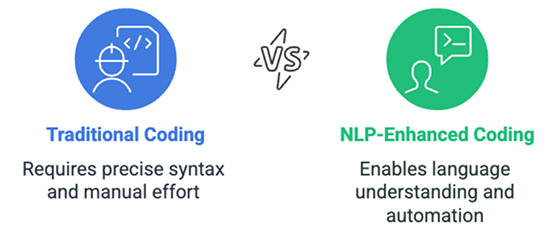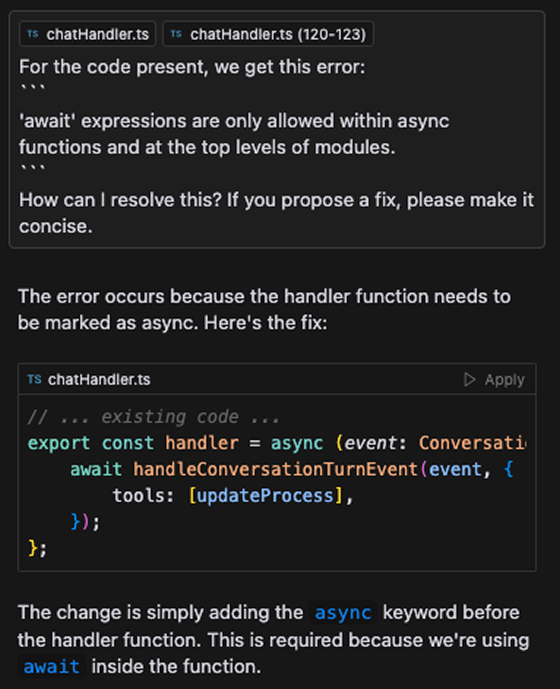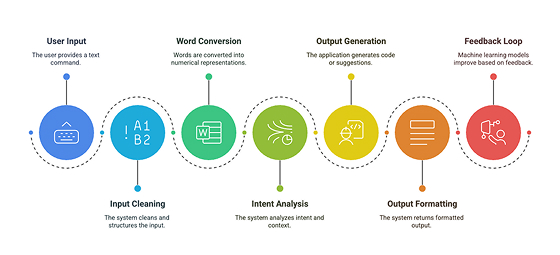Natural Language Processing (NLP) is changing the world of software development by enhancing the connection between human languages and coding languages. The evolution of natural language processing development started decades ago with achievements like the rule-based systems of the 1960s and the statistical models of the 1990s. The recent introduction of ChatGPT by OpenAI significantly boosted public awareness and adoption of NLP.
How NLP Is Changing the Development Landscape

Traditional coding requires developers to translate their ideas into precise programming syntax. NLP flips this paradigm by enabling machines to understand and generate human language. Now, developers can use NLP to
- Write code faster through intelligent auto-completion and suggestions.
- Convert natural language descriptions directly into functional code.
- Automate documentation and error detection.
- Make coding more accessible to beginners.
This shift is particularly valuable as software development demands continue to grow while technical talent remains scarce. Tools like GitHub Copilot demonstrate how natural language coding can enhance productivity by suggesting entire functions based on comments or context. Tools like Cursor also generate code faster and more efficiently, writing code in multiple lines simultaneously.
Using NLP for Coding
NLP has transformed several aspects of the development process:
1. Intelligent Code Assistance
- Modern IDEs like VS Code, JetBrains, and Cursor now feature NLP-powered code completion.
- These tools analyze coding patterns and provide real-time suggestions to speed development and reduce errors.
- Popular tools include GitHub Copilot, Cursor, Qodo, and Tabnine.

2. Natural Language to Code Conversion
- One of the most powerful applications of NLP is translating plain English into executable code.
- A developer can write “create a function that sorts an array in ascending order,” and NLP models can generate the corresponding implementation.

3. Automated Documentation
- NLP tools can analyze code and automatically generate documentation, comments, and README files.
- This addresses one of development’s most neglected yet critical aspects.
4. Code Quality Improvement
- NLP models can detect issues related to readability, efficiency, and maintainability.
- They enforce best practices and ensure consistency across codebases through automated code reviews.
5. Bug Detection & Debugging
- NLP-powered tools suggest possible fixes based on historical debugging patterns.
- They provide human-readable explanations of errors.
- Some tools even automatically correct syntax issues.

6. Test Case Generation
- NLP can automatically generate test cases based on function logic, reducing manual effort in writing unit tests.
- This reduces human error and ensures edge cases and error handling are covered.
7. Code Optimization & Performance Tuning
- NLP models can analyze existing code and suggest performance improvements.
- AI detects redundant operations, inefficient loops, and memory-intensive functions and provides optimized alternatives.
8. Multilingual Coding
- NLP can provide automatic translation of code between different programming languages.
- This helps developers work seamlessly across multiple languages without rewriting logic from scratch.
Inside an NLP Coding Application: How it Works

Here are the steps that happen inside an NLP application to provide understandable output.
- The user provides a text command (e.g., “Write a Python function to sort an array.”).
- The system cleans and structures the input by tokenizing (splitting text into words/phrases) and normalizing (standardizing format, removing stopwords).
- Words are converted into numerical representations (word embeddings like Word2Vec, BERT, or GPT) so the model can process them.
- The system analyzes intent and context using models like GPT-4, Codex, or Gemini.
- The application generates a code snippet, explanation, or debugging suggestion.
- The system returns formatted output and may offer optimizations or explanations.
- Machine learning models improve based on feedback.
This entire process happens in milliseconds, creating the illusion of instant understanding. However, each step represents years of research condensed into a seamless user experience.
Ethical Considerations
As with any AI technology, implementing NLP in development requires attention to ethical concerns.
- Bias in language models can perpetuate stereotypes in generated code.
- Privacy protection must be prioritized when handling code and documentation.
- Fairness should be ensured across all demographic groups.
The Future of Natural Language Coding
The trajectory of NLP in software development points toward even more seamless integration between human language and code. Emerging trends include:
- Enhanced reinforcement learning models that improve through developer feedback.
- Advanced transfer learning that makes sophisticated models accessible to smaller projects.
- Multilingual models that break down language barriers in global development teams.
Conclusion
When it comes to software development, NLP tools are changing the ways programmers write, debug, and maintain programs. Programmers equipped with AI-powered coding tools can write better code with fewer errors and automate redundant tasks. Within the next few years, NLP will significantly change software development, making it more efficient, consistent, and accessible.
